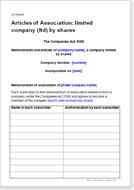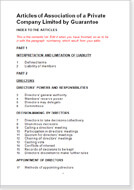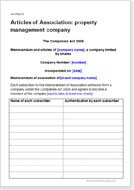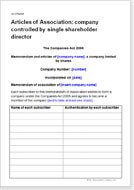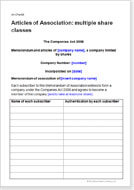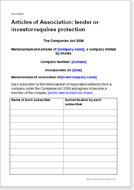Why it is important to use customised articles for your company
Articles of association are the legal constitution of the company, which set out how the company will be managed by the directors on behalf of the owners. The word article means much the same as paragraph or provision.
It does not matter what business is operated by your company. Articles the rule book for operating your company. They can cover such matters as a director's duties, the powers and responsibilites of the company secretary, when dividends and interim dividends may be paid, voting rights in certain matters of the shareholders, the process for appointing directors and removing them.
The framework provided in these sets of documents is based on the model articles provided by the Companies Act 2006. That act freed us from the longstanding straight jacket of a document few people dared to edit. Now a company can operate under the structure best suited to achieve its objectives, rather than being bound under the same rules as every other company.
The Companies Act 2006 replaced Table A (under the Companies Act 1985) with the model articles, effectively a simplified and more modern version of Table A, which have become the default for companies incorporated after 1 October 2009. You can read a comparison of the model articles with Table A.
However, the problem remains that these are very unlikely to suit your company. They are simply the default set that someone has decided is the best compromise for most businesses. There are many additions and omissions that are unworkable or impractical for a private company.
Yet they are the rules by which you must operate. So if you want to work by different rules, you need to customise these as per your structure.
As a company grows, how it is operated changes. New directors might be appointed, the objectives of the business might evolve, or how the company is financed might change.
To avoid having to change your articles frequently, it is also sensible to draw them in ways that suit how your company might be operated in the next few years, not just what you need today.
Do you need a memorandum of association?
On incorporation, every company must submit a memorandum of association to Companies House as well as articles.
The memorandum of association is a legal statement of intent, signed by all initial shareholders and guarantors agreeing to form the company.
A company that was incorporated before the Companies Act 2006 came into force was required to deliver a memorandum of association that set out:
- the share capital of the company at incorporation
- the initial subscriber for the shares of the company
- the company's objects
- whether the company had limited liability
The objects were a statement of the purpose of the company, including a general scope and more detailed permitted activities. The objects are no longer needed. It became apparent that listing what the company could and couldn't do before it started trading limited its ability to adapt at a future date. If the objects were kept general, such as 'to acquire or take over any similar business', 'to purchase any relevant intellectual property rights', or 'to borrow or raise finance for expansion' in order to remain flexible, then there wasn't much benefit in describing them.
Since 2009 the requirements for the scope of the memorandum have been reduced so that it is a snapshot of the company structure at the date of incorporation. Although many companies founded before 2009 still use an old style memorandum, nearly all new companies have the simpler memorandum with unrestricted objects. This follows a prescribed form set out in Schedules 1 and 2 of The Companies (Registration) Regulations 2008 and includes:
- the registered company name
- the date of subscription of the shares
- the Act of Parliament under which the company is incorporated (the CA 2006)
- whether the company is limited by shares or limited by guarantee
- the name of each subscriber to the shares
About our sets of documents
Net Lawman offers various alternatives - each covering different scenario, creates a unique structure.
Within a document, every individual article has been drawn with great care, not only as a standalone rule but to tie in with the other articles so as to produce a seamless constitution for your company.
As with all our documents, the drafting notes give you our comments on every provision and make it very easy for you to edit to your precise requirement.
For more detailed information, you can read structuring your company through your articles which explains in more detail.
What you will find in your document
All of these sets of articles:
You should also put in place related documents including a shareholders’ agreement and director’s service contracts.
Within the framework that the articles set out, you need to set more detailed rules for the relationships between directors and shareholders.
Articles of association can be changed - but only with the consent of at least 75% of the shareholders. In most companies, the articles are changed extremely rarely.
In the future, when someone wants to sell his shares or a new director is appointed, you will want to be able to change who does what, without having to change your articles of association. All of that detailed control is best exercised through a shareholders agreement.
In the unlikely event that your company fails, as a shareholder you will probably lose everything. However, there is an exception.
In a winding up, certain payments to employees are priority creditors. That includes money due to a director. It follows that a director’s service contract can provide strong protection and may enable a director to claim a more substantial sum of money that might otherwise be possible. You should also consider putting in place strong directors service contracts if you have not already to avoid directors making preferential payments to themselves if the company is ever in trouble.

